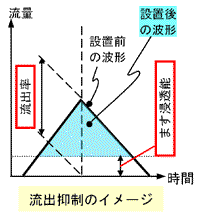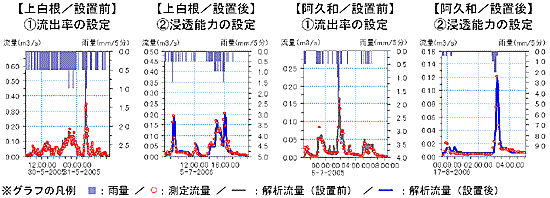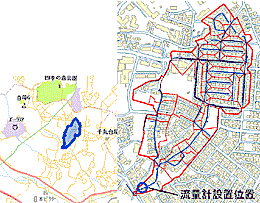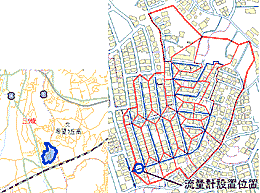- Yokohama-shi Top Page
- Living and Procedures
- Community Development and Environment
- Rivers and sewers
- Sewer
- Connection to the sewer
- Rainwater infiltration
- Slowly draining rainwater (rainwater penetration) effect [second report]
Here's the text.
Slowly draining rainwater (rainwater penetration) effect [second report]
Last Updated May 13, 2024
Effects of promoting the installation of rainwater infiltration masu (experiment results)
- About 70 cups of a 25m pool can be penetrated underground per year in a complex.
However, when calculated based on light rain [3(2) A.That's it. - For heavy rain, there is a reduction effect of about 5 to 10%, and flood damage is reduced.
However, when estimated at 25 to 43 pieces per hectare [3(2) B.That's it.
1 Purpose
Promotion of the installation of rainwater infiltration masu has the effect of recharging groundwater, reclaiming water circulation, and suppressing rainwater runoff. This time, we investigated the effect of controlling runoff (the effect of infiltrating rainwater into the ground) when installing rainwater infiltration masu in housing complex.
2. Details of the survey
(1) Location and scale
| Items | Kamishirane, Asahi-ku area | Akuwahigashi, Seya-ku area |
|---|---|---|
| Wastewater area | 12.6ha | 6.8ha |
| Number of installations | 316 pieces | 291 pieces |
| Installation density | 25 pieces/ha | 43 pieces/ha |
| Guide map |
|
|
450mm connection and city area
※Generally, it is said that 20 to 40 pieces / ha is effective in the entire basin.
(2) Comparison
| Items | Before installation | After installation | |||
|---|---|---|---|---|---|
| Period | H16.9.1~H17.12.31 | H18.6.1~H18.10.31 | |||
| Location | Kamishirane | Akuwahigashi | Kamishirane | Akuwahigashi | |
| Number of rainfall (times) | 143 | 139 | 54 | 53 | |
| Rainfall scale (Large rain) | Maximum total rainfall (mm) | 278.0 | 254.5 | 120.0 | 111.5 |
| Maximum hourly rainfall (mm/h) | 58.0 | 31.5 | 61.0 | 57.5 | |
(3) Data and Analysis Methods
Adata
Rainfall and flow rate of sewer pipes
B. Analysis Methods

Incorporate the rainwater penetration masu function into the runoff analysis model (= specialized technical calculation software) to confirm the installation effect.
- Based on the results of the flow survey before the installation of the infiltration facility (rainfall, sewer flow rate), how rainwater in each area flows out (e.g., runoff rate) is set.
Outflow rate: Percentage of rain flowing to the surface of the earth. More penetration Noh: Rainwater infiltration is its ability because rainwater from a gutter etc. penetrates underground before it flows to the surface of the ground. - Based on the results of the flow survey (rainfall, sewer pipe flow) after the installation of the infiltration facility, the penetration capacity of rainwater infiltration masu in each area is set.
(Because the penetration capacity varies depending on the soil quality of each district.) → Go to 3(1) - Calculate the amount of rainwater runoff using actual rainfall when there is no infiltration facility (before installation) and when there is (after installation).
- Verification of penetration effect by comparing calculation results → Go to 3(2)
3 Effects analysis
Examples of analysis results by spill model

- Average rainfall during the observation period (in the observation period, it was a year with little rainfall)
Looking at the average rainfall for total rainfall, rainfall per hour, and rainfall duration, the rainfall record during the observation period shows that the total rainfall was 16 mm, 5 mm per hour, and 6 hours of rainfall was "light rain". - Infiltration effect in light rain
Estimation of permeation effect for one year
In 2 districts, it rains about 100 times a year. Therefore, assuming that "light rain" has fallen 100 times, the permeation effect for one year is estimated as follows.
| Items | Kamishirane, Asahi-ku area | Akuwahigashi, Seya-ku area | |
|---|---|---|---|
| District Overview | Wastewater area | 12.6ha | 6.8ha |
| Number of installations | 316 pieces | 291 pieces | |
| Amount of permeation in the entire area of light rain | 369m3 | 333m3 | |
| 1 year (100 times) Amount of penetration | The entire district (25m pool conversion*) | 36,900m3 (about 74 cups) | 33,300m3 (about 67 cups) |
| Per piece (equivalent to 20L kerosene cans) | 117m3 (for 5,850 bottles) | 114m3 (for 5,700 bottles) | |
※25m Pool: 25m long x 16m wide x 1.3m water depth = 520m3 → Assuming 500m3
In each district, if you replace it with a 25m pool, about 70 cups a year, and about 5,700 rainwater per year per 20L kerosene cans permeate underground, which will be useful for groundwater recharge.
In the event of heavy rain (the rainfall per hour is 30mm to 50mm), the penetration effect was as follows in the survey area.
| Survey area | Kamishirane, Asahi-ku area | Akuwahigashi, Seya-ku area | |
|---|---|---|---|
| Installation density of penetration facilities | 25 pieces/ha | 43 pieces/ha | |
| Total flow rate flowing into the sewer pipe Percentage of penetration | At 50mm/h | 4.9% | 10.1% |
※Calculation conditions: Use rainfall intensity type. Rain duration was 1 hour.

In this study case, if 25 to 43 rainwater infiltration masu per hectare is installed against heavy rain of 50 mm/h, the total flow rate is expected to be reduced by about 50% to 10%.
C. Issues
The results of this experiment are not clogged with garbage or fallen leaves for about one year after installing the rainwater infiltration masu, but in order to continue the effect, cooperation of citizens such as cleaning is required is.
Inquiries to this page
Sewerage River Bureau Management Promotion Department Management Promotion Section (plan)
Telephone: 045-671-2838
Telephone: 045-671-2838
Fax: 045-664-0571
Email address: gk-management@city.yokohama.lg.jp
Page ID: 152-399-217









